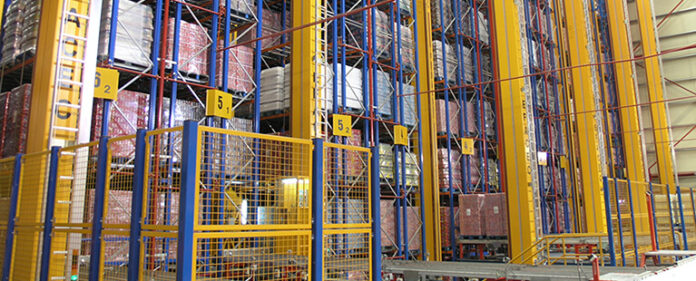Automated Storage and Retrieval Systems represent a pinnacle of efficiency and innovation in warehouse management. These systems, characterised by their ability to automatically store and retrieve goods, have become indispensable in modern logistics operations. Offering a fully integrated solution, ASRS solutions encompass stacker cranes, conveyors, automated guided vehicles, and sophisticated warehouse management software.
They streamline processes from storage to retrieval, optimising space utilisation and enhancing productivity. With applications ranging from traditional pallet-based systems to high-speed mini loads, ASRS caters to diverse operational needs, including those in specialised environments like deep freeze or hazardous conditions.
ASRS providers have successfully delivered hundreds of functional systems worldwide, ensuring seamless operations and heightened efficiency across industries.
What are the benefits of automated storage and retrieval systems?
Enhanced Operational Efficiency:
Automated Storage and Retrieval Systems (ASRS) vary in storage arrangements, transfer methods as well as horizontal and vertical velocity options so as to enhance productivity and streamline activities.
Optimised Space Utilisation:
ASRS systems maximise the usage of floor space and vertical heights; thus providing efficient warehouse storage means using high density solutions.
Real-Time Inventory Management:
Integrated inventory management software ensures there are no manual checks on stock levels as it provides accurate prevailing inventory positions.
Inventory Protection and Accuracy:
ASRS systems improve stock security and reduce risks associated with damaged or lost items by using secure storage and better picking methods.
Improved Workflow Efficiency:
Warehouse design, layout, and flow are optimised by ASRS systems so that travelling distances between functions are minimised, leading to shorter order cycles.
Tailored Solutions for Every Need:
Most of the ASRS vendors offer custom or turnkey solutions made specifically for each operation’s needs.
Simplified Installation and Maintenance:
Built-in diagnostics as well as modular designs make installation of an ASRS system less complicated thereby minimising downtime hence maximising throughput during production hours.
Adaptability to Challenging Environments:
Such factors like seismic zones or specific temperature requirements do not pose any challenges on the functioning of these automated warehouse equipment implying that they can be used in a wide range of conditions without breaking down.
Seamless Integration with Larger Systems:
By integrating with larger warehouse management systems, ASRS systems optimise operational efficiency and productivity while also improving ergonomics within a workspace thus making it easier for workers to operate freely in the space without straining themselves too much.
What are the factors that impact the size, extensibility and function of your new automated storage and retrieval solution?
Inventory Characteristics:
Design and capacity of the storage system is determined by size, shape, weight, and fragility of inventory items. Different kinds of inventories might need special storage arrangements and handling devices.
Storage Requirements:
The magnitude of stocks to keep and how often they are accessed influences the expanse and capabilities of a storage solution. High density storage systems may be required when there is minimal floor space in warehouses that needs to be maximised.
Future Growth and Scalability:
It’s important for a storage system to have future growth potential. Scaling features like modularity, expandability, as well as easy integration with supplementary components enables it to fit changing operational demands over time.
Workflow and Process Optimization:
For instance, an order fulfilment process should be supported by an appropriate warehouse design. Such issues as pick methods employed in orders, ordering points for re-stocking activities, material flow patterns affect the layout or function of this setup.
Technological Integration:
To ensure uninterrupted functioning as well as data transmission among various divisions or units so far existing such as; Warehouse Management Systems (WMS), Material Handling Equipment (MHEs) and Inventory Tracking Systems.
Space Constraints and Layout:
Storage system’s design and configuration are affected by the architectural attributes like layout, ceiling height, floor space, and aisle width. It means that in order to maximise storage capacity, necessary changes may be required for them to fit within existing space limitations.
Operational Requirements and Constraints:
The choice of storage/retrieval technologies and design of the whole system is influenced by aspects such as throughput rates, cycle times, order fulfilment goals or labour requirements.
Regulatory and Safety Compliance:
Fire codes, seismic requirements and ergonomic guidelines are some of the industry regulations that have been set forth to ensure safety while operating storage systems within a legal framework.
Budget and Cost Considerations:
Size, scope and features of a storage solution are determined by available budget and cost constraints. Therefore putting functionality on one hand while being conscious about its costs on the other side helps in developing a system that can operate functionally with regards to operational needs vis-à-vis budgets.
What are the 10 Signs it’s Time for ASRS Systems?
Repetitive Replenishment Tasks:
It is a sign of inefficiency and unproductive workforce when workers take too long to restock inventory. Automation can simplify the processes of replenishment freeing up time for more value-added activities.
Long Travel Distances:
When there are long distances between the locations where inventory is stored, it means that time is wasted and productivity falls. With automated storage and retrieval system locations are optimised so as to reduce travel time and minimise distances between picking stations and storage areas.
Extended Search Efforts:
If workers have to use their eyes to locate items or match part numbers after arriving at picking destinations, then such systems are inefficient. Automation among other things automates inventory retrieval and identification hence improving accuracy, reducing search time etc.
Increasing Picking Errors:
An increase in the number of picking errors may result in financial losses and brand damage. Automated picking process minimises errors by using precise automated systems hence ensuring that orders are filled accurately at all times.
Struggling Order Throughput:
The difficulty in meeting order cut-off times or reliance on temporary employees points towards inadequate throughput capacity. Automated shipping cycles enhance output by streamlining order processing workflows while reducing cycle times.
Frequent Inventory Damage:
The presence of damaged inventory suggests handling and storage practices which are not efficient. Automated techniques in the industry help reduce risks of damage by causing controlled mechanical handling processes that minimise human errors and mismanagement.
Inventory Misplacement:
Often stock is put in the wrong place or lost, leading to inefficient operations and delays. With automation, it becomes easier to manage stocks as one can easily track and find them while preventing losses.
Unexplained Inventory Losses:
This may lead to financial losses as well as operational disruptions due to unexplained differences in stores. Automation should be preferred for security and accountability in inventories like minimising thefts and unauthorised access.
Facility Space Constraints:
At maximum capacity, a facility will have adverse effects on operational performance thereby restricting prospects for future expansion. Therefore, automating the process will allow storage that can accommodate high-density solutions which maximise utilisation of space and facilitate future expansions.
Worker Safety Concerns:
The possibility of injuring workers when doing manual material handling tasks necessitates automating them. This means there will be no more lifting or carrying anything around.
Summary – Modern warehouse management relies on Automated Storage And Retrieval Systems which provide efficiency, accuracy and scalability features. Godrej Koerber, a market leader in ASRS, pioneers innovative solutions tailored to diverse industry needs, driving operational excellence and setting industry standards worldwide.
Write and Win: Participate in Creative writing Contest & International Essay Contest and win fabulous prizes.
















